|
Riley Wheels
In the early motoring years wheels were a permanent fixture on all manufacturers vehicles, in the event of a tyre failure the vehicle would be stranded until a time consuming repair or replacement was able to be carried out at the roadside, very inconvenient for the modern traveller! Detachable rims were the first advancement allowing a "spare" to be carried with the vehicle making for a speedier repair to be carried out. The Riley Company saw room for improvement here so they designed and marketed a patented detachable wheel. These were generally available by 1907 and formed an important sideline for the company, the 9 hp Riley was the first car to supply detachable wheels as standard. At the 1908 Olympia Motor Show most of the cars on the Riley stand were fitted with the Riley detachable system. At the 1910 show all the cars had the larger 32" wheels and Riley detachable system, also at the show in the accessory section Riley had a seperate stand to demonstrate their detachable wheel system.
The detachable wheel section of Riley was becoming very lucrative with factories in France and Germany and by 1912 some 183 manufacturers (see list near the bottom of this page) were fitting Riley detachable wheels with 10% going to the USA, they continued to be shown on seperate stands at the motor shows.
However it seems at about the same time others were developing and patenting their own detachable wheel systems, namely J.V.Pugh of Rudge-Whitworth Ltd , E.F.Goodyear of the Goodyear Wheel Co., Sankey and maybe up to two years earlier J.S.Napier all bearing close resemblance to each other. Litigation carried on for many years over these patents but ended with the outbreak of the 1914-18 war when Riley turned their factories over to the war effort.
Following the Armistice in 1918, during a company reorganisation it was agreed to cease detachable wheel production to concentrate on resuming car production so from then on all cars were fitted with Riley manufactured offset laminated steel-disc wheels, these wheels were made by riveting together two, three or more discs of varying diameter, the number of discs used depending on the load the wheel was required to carry, although an apparently heavy method of construction they compared favourably with a wire wheel.
In 1922 cars started to be fitted with wire wheels again but from 1933 the familiar six-stud Riley
wheel was replaced by the Dunlop centre lock wire wheel on all models, these
were the first wheels fitted on Riley cars which had not been made by the Riley
factory.
Right - Riley stand Brussels 1911 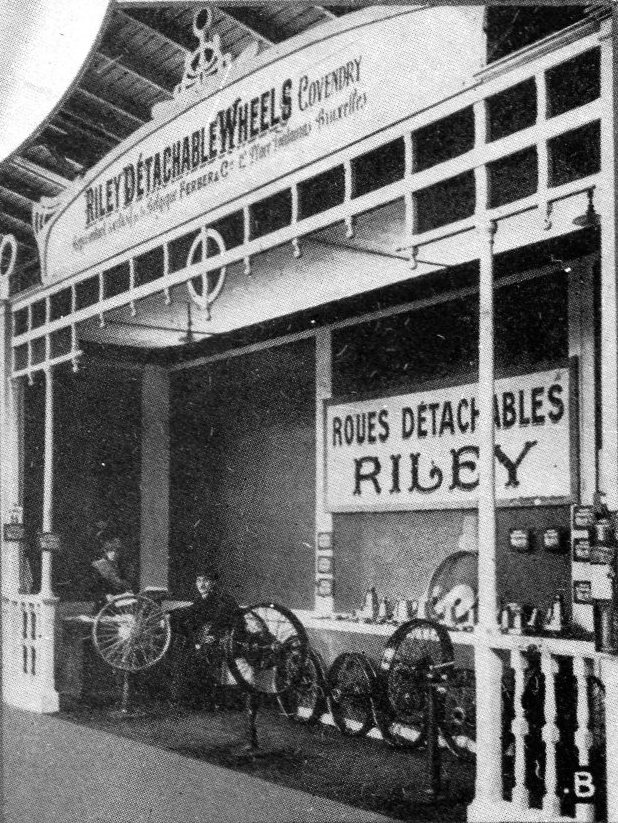 and Riley stand 1912 
Below - On the 11th to the 22nd January 1913 in Brussels there was an Exposition (a large scale public exhibition or show) for Automobiles, Cycles and Aeronautics, this was the twelfth such annual event, in the Accesories section of the programme, Ferber, a Riley detachable wheel distributor had a stand (number H 60), their entry is shown here along with the official guide cover.
Below - from a Riley catalogue dated 1912
Riley Detachable
Wheels.
Description. – Figure 1 is
an illustration of the inner hub (back).
Permanently fitted to the inner hubs are the brake drums,
the usual ball bearings, and, when fitted, the speedometer rings, etc. It will be readily understood, therefore,
that when the removable wheel is withdrawn these fittings are left intact with
the inner hubs, and are in no way disturbed.
The outer, or removable hub, which is built up into the road
wheel (figure 1B), is mounted upon the taper seating of the inner hub, the
projecting studs of which engage with the corresponding holes in the outer
hub. These studs are tapered to a
considerable degree to facilitate quick locating.
The long taper seating which was introduced in the 1911 type
wheel has proved one of the most important improvements in detachable wheel
design and is has naturally been retained without change for the 1912
wheel. As is now well known, this taper
or conical seating takes practically the whole of the drive, thus relieving the
studs to a corresponding degree.
Consequently having little or nothing to do the driving studs no longer
signs of wear even after long usage, thus obviating the disadvantage which has
been urged against this form of drive when used in combination with the old
fashioned parallel seating hubs. Every
engineer knows how extremely difficult it is to get an absolutely close
parallel fits between parts which are intended to be quickly removable and
interchangeable, a difficulty which the adoption of the taper seating has
overcome.
A further advantage of the Riley Taper Seating is that the
rapid withdrawal of the wheel is facilitated, “rusting” and “seizing on”
troubles, which have always been associated with detachable wheels mounted on
parallel seating have been entirely obviated.
Each of the wheels is provided with a permanently attached
(but free to rotate) hub cap, which is screw threaded, to screw on to the
thread of the inner hub. Self-contained
in this hub cap are the automatic and positive locks, and also the withdrawal
device.
The outer hub shell has ratchet teeth cut on its end face
(see figure 2) which are adapted to be engaged by the plunger pawls of the hub
cap. These pawls are pressed into
engagement by large flat springs, and, as will be seen, one of the pawls is
fitted with a swinging cover, which not only ensures that its pawl is
positively locked, but it further prevents the spanner being removed from the
hub cap until ONE of the pawls is in POSITIVE engagement, quite independent of
spring action, and the other in ACTUAL spring engagement (see figure 3).
The method of detaching the wheel is clearly shown by
reference to figure 4, the spanner being shown in an “unscrewing position” with
the hand cover swung outwards, and the claws of the spanner having withdrawn
both pawls from engagement, leaving the hub cap perfectly free to be unscrewed,
the wheel being withdrawn by the action of unscrewing.
Figure 4 shows the spanner applied to the hub cap in a
“screwing up” position, with the hand cover swung outwards, it being perfectly
obvious that it is necessary to move out of its locked position the hand lock
before turning the spanner. This
illustration readily conveys the idea that the hand lock must be swung inwards
(thus positively locking the pawl) before the spanner can be removed from the
hub cap.
The two pawls and the ratchet are so arranged that when one
pawl is in engagement the other is of necessity also in engagement ; our claim
that it is impossible to withdraw the spanner from the hub cap except when both
pawls are in actual and positive engagement, is therefore clearly
substantiated.
The Riley Locking Device, therefore, in a few
words, consists of two separate and independent automatic pawls, with a further
additional safeguard of the hand-operated positive lock, which moreover,
prevents the removal of the spanner until all locks are properly engaged. It is in fact, therefore, a “treble lock,” a
description which has been applied by an enthusiastic owner as being more
correct than the term “double lock” hitherto employed.
Riley detachable wheel article
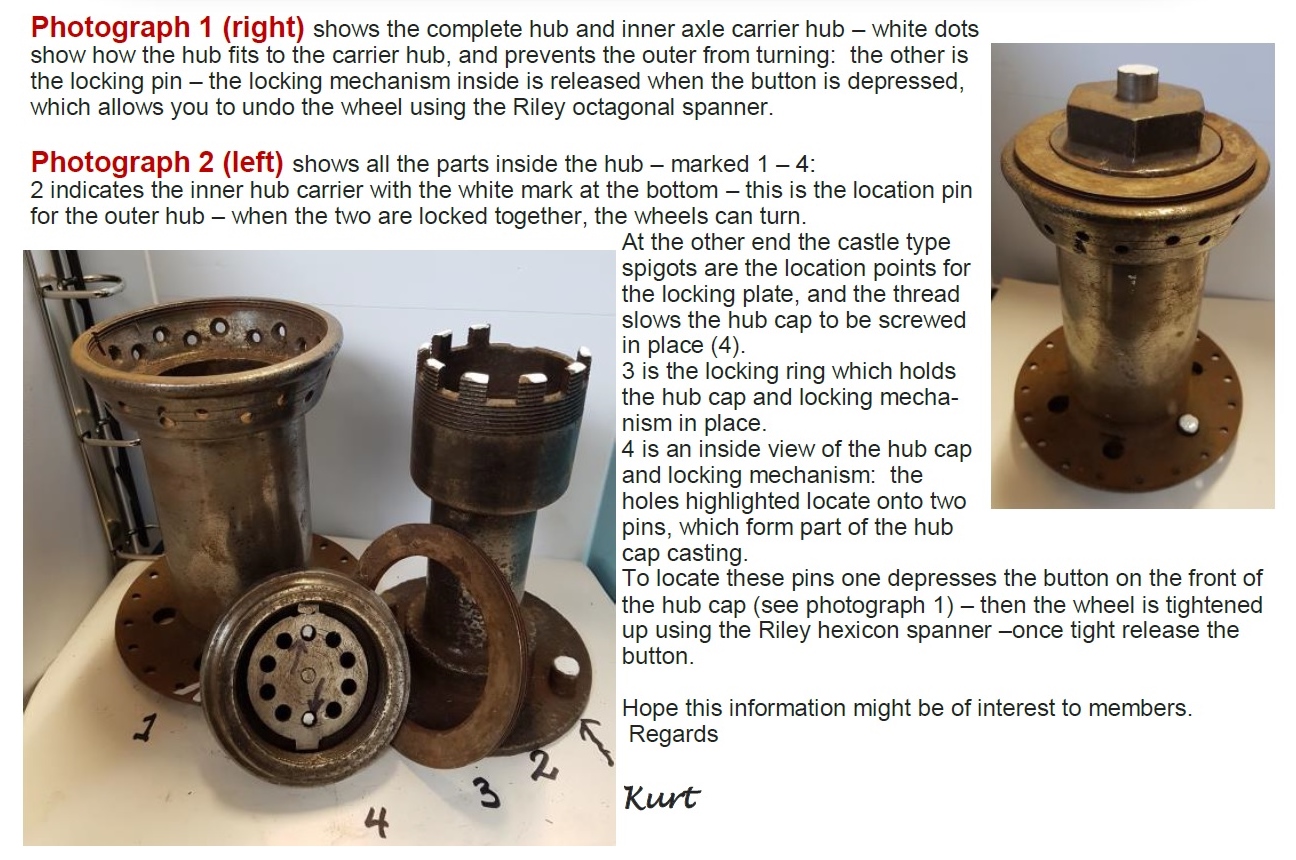
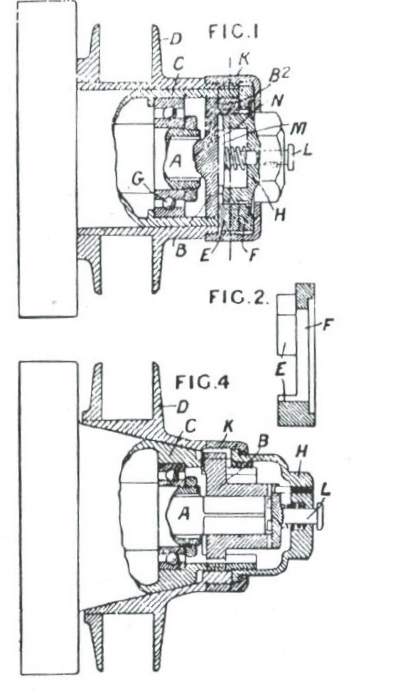 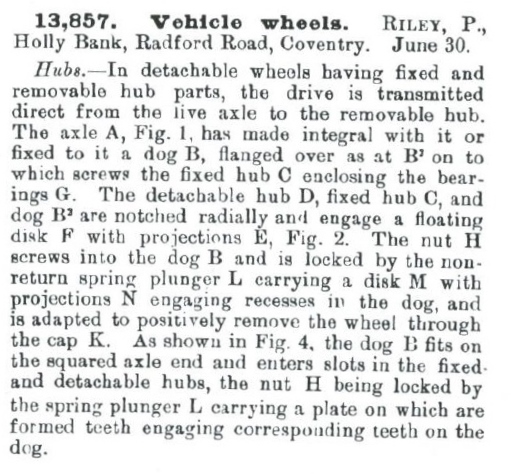
Below - header of an early French motoring magazine followed by a shortened and roughly translated article from 1911, the description of the the Riley detachable wheel system is not shown as it is the same as the English version above.
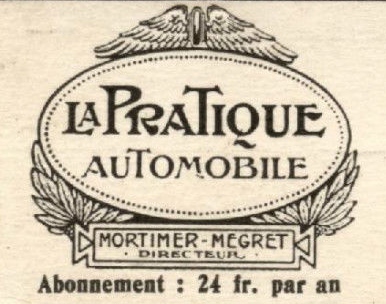
Automotive practice, Detachable wheels, Riley wheels.
The detachable
Riley wheel is very widespread in England. Its success is due to its
simplicity, robustness and reasonable selling price.
No other makes though
possess the same simplicity, easy assembly and disassembly, and the same
robustness.
With this system you
don’t have to worry about trouble on the road with a wheel that you cannot get off.
No delicate or complicated parts made with such precision that the driver is
unable change it; the wheel is simply positioned by six studs and held on by
one wheel nut; a blind person could fit it!
Some, who judge by impression and look, claim the steel wheel is
less robust than a wooden wheel: to this opinion, here’s the best answer, take
the case of the racing car driven by Grégoire de Romano, it crashed into a
ditch at the Boulogne circuit after rolling over. His Riley wheels were buckled, spokes broken
but remained intact. Wooden wheels would
surely have been pulverized!
An experienced
person will take two or three minutes to effect the replacement of a wheel.
Because of the
simplicity of its construction, having no delicate parts the Riley wheel
requires no special maintenance. If we have taken care to mount the wheel on a
slightly greasy hub, one can easily remove it a year after fitting.
Below - Header and 3 x 1912 adverts from an early Austrian motor magazine "Algemeine Automobiel Zeitune" (General Automobile Newspaper) the first weekly 28 page issue No.1 is dated 7th January 1900, it changed to every other week in March 1922 and to monthly in January 1932, the last issue was printed on the 1st July 1938.
Below - in 1912 the German company Errtee advertised Riley wheels, chains for tyres, vulcanisation equipment, friction
material for brakes, dampers, gloves etc.
 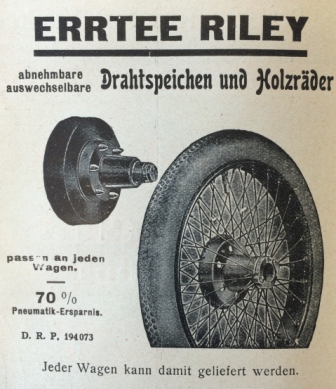
Below - some cars with Riley detachable wheels.
Below - some early Riley wheel adverts
Below - a Renault and one of the Riley wheel on it "Roue Riley".
Below - various wheel and spanner pictures including some of an original wheel and hub owned by Roland Dhondt from Belgium who is an avid wheel collector and without his help I would not have been able to compile this page, also shown is a wheel in situ on a 1914 Belgium Germain car from the collection of cars that belonged to the late Dr Thiery, picture taken by Roland Dhondt. Spanner pictures on blue background and other pictures kindly provided by Gordon Thomas, Autovia and Riley owner.
Below - Riley car with Riley manufactured offset laminated steel-disc wheels.
Below - 200 hp Benz that was driven at 170km/hr using Riley detachable wheels.
Below - a 1915 advert for Belsize cars fitted with Riley detachable wheels and a page from "The Autocar Imperial Year Book" 1912 singing the praises for the Riley Detachable wheels and a list of some of the manufacturers using their wheels.
Below - a 1912 list from a Riley catalogue, 128 in total although reports say over 180 manufacturers used them.
Riley Wheels have been
fitted to practically every known make of car, the following being recent cars
so equipped:-
Adams, Adler, Alldays, Alpha, Aquila, Argyll, Ariel,
Armstrong Whitworth, Austin, Austrian-Daimler.
Bedford, Belhaven, Bell, Bellsize, Bentall, Benz, Berliet,
Bianchi, Brasher, Briton, B.S.A., Brown.
Cadillac, Calthorpe, Chalmers, Charron, Chenard Walcker,
Clement-Bayard, Clement-Talbot, Clyde, Crossley.
Darracq, Deasy, De Dietrich, De Dion, Diatto, D.F.P.,
Delage, Delahaye, Delaunay Belleville, Dennis, De Vecchi, Durkopp.
Electric Motor Vehicle, E.M.F.
Fafnir, F.I.A.T., F.I.F., F.L., F.N., Flanders, Ford.
Germain, Gregoire.
Hermes, Hiller, Hillman, Hotchkiss, Hudson, Humber,
Hupmobile.
Isotta-Fraschini, Itala.
Jackson.
La Buire, Lagonda, Lancia, Laurin-Klement, Lloyd,
Lorraine-Dietrich.
Mass, Martini, Mathis, McCue, Mercedes, Meteor Cab,
Metallurgique, Miesse, Minerva, Mitchell, Mors, Motoblock.
Nacke, N.A.G., Nagant, Napier, National, Niclausse.
Orleans, Opel, Oryx.
Panhard, Pipe, Peugeot, Protos, Priamus.
Remo, Renault, Riley, Rolls-Royce, Rothwell, Rover.
Sava, Scacchi, Scnneider, Scat, Sheffield Simplex, Singer,
Sizaire, Spa, Spyker, Straker Squire, Sunbeam, Swift.
Thames, Thorneycroft, Turcat Mery, Turicum.
Unic.
Valveless, Vivinus, Vulcan, Vauxhall.
White, Wolseley.
Zeust.
Other cars using Riley wheels not shown in the list above.
(This should be over 50 names long, anyone who knows any more names to add please contact me)
Austro-Daimler.
Blitzen Benz.
FAB (Fabrique Automobile Belge),
Ferber & Cie.
Hispano-Suiza.
Pierce Arrow, Packard.
Below - as mentioned above much of the information on this page is provided by Belgium historian Roland Dhondt for which I am most grateful, below are some of his extensive wheel collection dating from 1898 to 1955 and also the cover and contents of his book detailing the evolution of motor car wheels which is available to purchase in English and Flemish, contact me if you would like to buy a copy.
If anyone has more information on Riley wheels please Contact Me
|